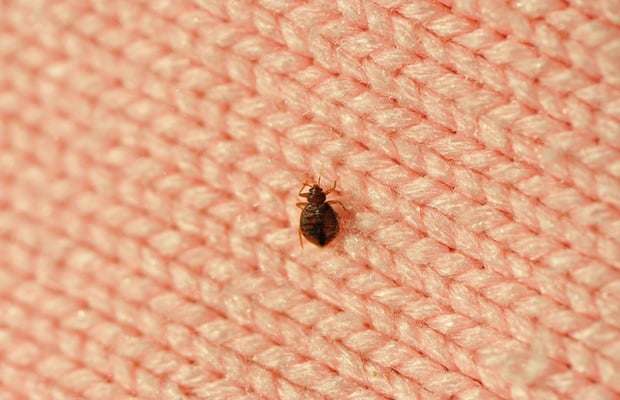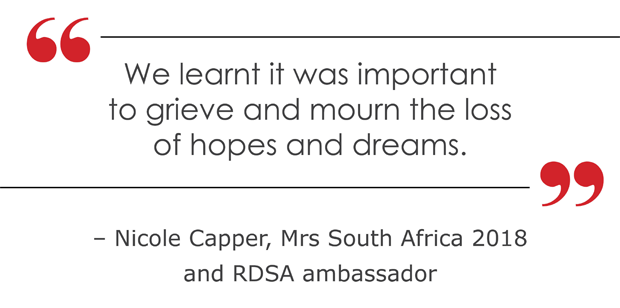While we all know there is a risk, no parent is ever prepared to hear a doctor diagnose their baby with any type of illness, let alone an incurable, rare disease.
Nicole Capper was crowned Mrs South Africa 2018 and is avidly using that platform to create awareness about rare diseases.
Inflammation and infection
The topic is incredibly close to her heart, especially since her daughter, Tatum, was diagnosed with cystic fibrosis at just six weeks old.
“At three weeks, Tatum suddenly stopped breathing and turned grey. I rushed her to hospital where after three weeks she was diagnosed. Cystic fibrosis affects the lungs and digestive system. Tatum’s lungs are prone to inflammation and infection, and will deteriorate with age,” said Capper.
Capper and her husband, Brian, believe that if they had looked into their DNA and genetics, they could have prevented this from happening to their daughter.
“At first, I was an avid advocate for family planning and genetics counselling, especially among my family members. But with a disease that has more 3 000 genes to test for, testing is costly and not always foolproof.
“And as Tatum grows, I realise that I would not change her for anything in the world. Of course, I hate to see her suffer, but as a parent, you realise that if you and your children have the privilege of living long enough, you will all experience suffering at some point. No one is immune to the adversities life serves,” says Capper.
Learning and growing
Capper says that something like this is devastating for families. Having a “sick child” was one of her biggest fears, and when it happened it was the end of their lives as they knew it.
She says, “Naturally we felt responsible for the fact that she has this disease. It was our genes that gave her the condition, but with counselling and seeing a psychologist, we were able to work through these feelings in a healthy way.
“We learnt it was important to grieve and mourn the loss of hopes and dreams. It was important to come to an acceptance of the severity of Tatum’s condition, and then to grow into gratitude for how much she does have, and realise how this challenge has truly redefined our perspective and purpose.”
Capper added that families who are going through this kind of ordeal should know that while it is earth-shattering and hard to come to terms with, they should be patient with themselves and go through the emotions to heal. They must know that things will get better and that it’s an opportunity to turn one’s life into one of pure joy and gratitude.
Awareness of rare diseases
February 28 marks International Rare Disease Day and the theme is “research”. Non-profit organisation Rare Diseases South Africa (RDSA) is encouraging people to learn about their genealogy and family trees.
Another SA mom, Kelly du Plessis, started advocating for more awareness around rare diseases 11 years ago, encouraging people to be informed about their genealogy and learn more about potentially life-threatening illnesses.
Du Plessis is the CEO and Founder of RDSA, and is dedicated to raising awareness about rare diseases and helping those who have them – like her son, Juan.
She established the organisation after her newborn son was diagnosed with Pompe’s disease, a life-threatening condition that affects the heart and muscles.
“When it happens to you, you very quickly become aware of what needs to change in society, and I realised I had to make a change for my own sanity, and to feel like our journey wasn’t in vain,” says Du Plessis.
Researching rare diseases
Du Plessis adds that her efforts are aimed at getting people to research their genes so that they can become aware of diseases, conditions and predispositions they may have in their family tree.
“Approximately 80% of rare diseases are genetic in nature, and are therefore carried down through your family bloodline. It doesn’t seem like a big thing, but knowing the possibilities makes you more aware when planning a family and understanding your risk of passing a disease on to your children. This will allow you to adapt your plans when considering starting a family.
“This knowledge also assists you in understanding what treatments may or not be available to you in the world of precision medication,” says Du Plessis.
Learn about your genetic history
Knowing your family tree and genetic details is an important message RDSA and Capper want to get across.
While genetic testing is quite pricey, it is more accessible than it used to be. US gynaecologist and obstetricians are advised by the American College of Obstetricians and Gynaecologists to offer pre-pregnancy carrier screening for genetic diseases, according to The Conversation.
These tests screen both parents for any mutant genes. If either parent has a mutant gene, it doesn’t necessarily mean they suffer from or display the symptoms of a disease.
Should both parents carry a mutant gene, however, their child may have what is known as a recessive mutation or gene, which could result in a inherited, genetic disease, like muscular dystrophy or cystic fibrosis.
Prospective parents who cannot go the natural route to fall pregnant, have an option of Preimplantation Genetic Screening (PGS) and/or Preimplantation Genetic Diagnosis (PGD). These procedures test for chromosomal abnormalities and gene mutations to detect if the embryos have any abnormalities, which could result in rare diseases.
These tests come with a hefty price tag – anywhere between R25 000 and R60 000.
Incurable, but treatable
Most rare diseases are inherited and cannot be cured, but the symptoms and secondary illnesses that stem from the rare disease can be treated. Certain rare diseases cause severe deficiencies in certain enzymes, such as Fabry disease, which results in unhealthy fat build-up in various organs due to a lack of Alpha-galactosidase A.
Pharmaceutical company, Sanofi Genzyme, has partnered with the RDSA to launch this year’s annual Rare Disease Day.
Dr Rashem Mothilal, head of Sanofi Genzyme, told Health24, “Rare disease is an area with a significant, unmet need and as such, we invest in building sustainable partnerships with patient organisations and other stakeholders dedicated to prioritising the needs and increasing access to healthcare for patients and families affected by rare diseases.
“We also understand that having a life-saving treatment doesn’t mean much if it doesn’t reach those who need it. Over the last two decades, one of our programmes has provided free enzyme replacement therapy to more than 2 000 patients in 80 countries. And we will continue to work towards building healthcare systems which ensure long-term and sustainable support for the needs of patients with rare disorders.”
In a statement, Dr Mothilal added that the goal is to empower the lives of patients and families affected by a rare disease and to encourage leading role players to focus their efforts on diagnosis, research and care for patients with rare diseases.
Improving testing standards
Capper adds that if testing and diagnosis are done sooner, it could reduce or even avoid damage altogether.
Capper says, “Many countries test for diseases like cystic fibrosis at birth with a heel prick test, which I believe would dramatically reduce unnecessary lung damage before diagnosis.”
Du Plessis adds that rare diseases often go undiagnosed due to confusion about symptoms. “Many symptoms of rare diseases are similar to or mimic more common conditions, therefore, when doctors encounter a patient with these ‘common’ symptoms, it’s presumed they have a more common condition and are treated accordingly.
“Rare diseases are generally a combination of about seven to 10 ‘common’ symptoms, which together make up the rare disease. Improved diagnostic facilities and awareness, along with improved training at tertiary level are required in order to improve the diagnosis rates in South Africa.”
Misdiagnosis, or no diagnosis at all, could take its toll on those who have rare diseases, along with their families and friends.
There’s hope
In the meantime Tatum goes through four to six hours of therapy each day and has accepted that it is now part of her life.
“She is a happy two-year-old girl, who calmly lies down for hours of chest physiotherapy while watching a movie and uses her nebuliser at least three times a day. She knows her tablets are helping her pancreas, and she will tell you that she is a strong, big and powerful girl.”
Do you or someone you know have a story to share with us? Send it to healthnews@health24.com and we may publish your story. Please indicate if you would like to remain anonymous.
Image: Supplied – MoSparks Production/Nicole Capper
Stefni Herbert















